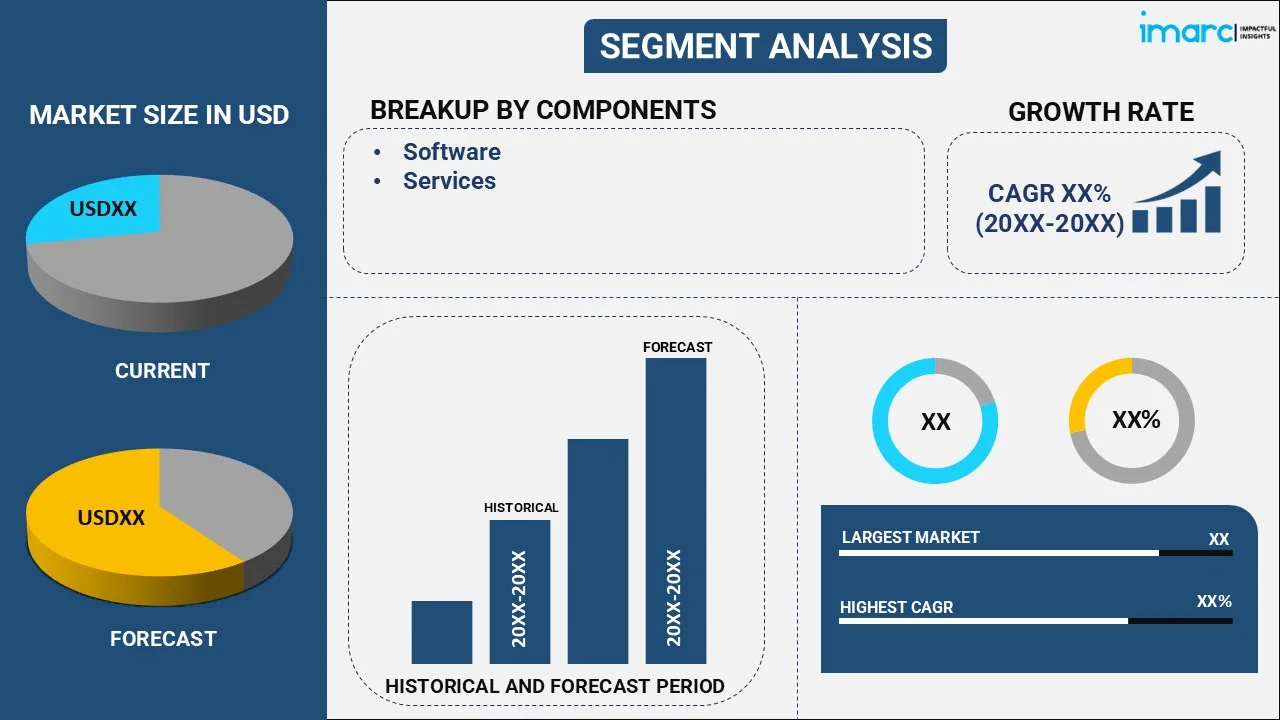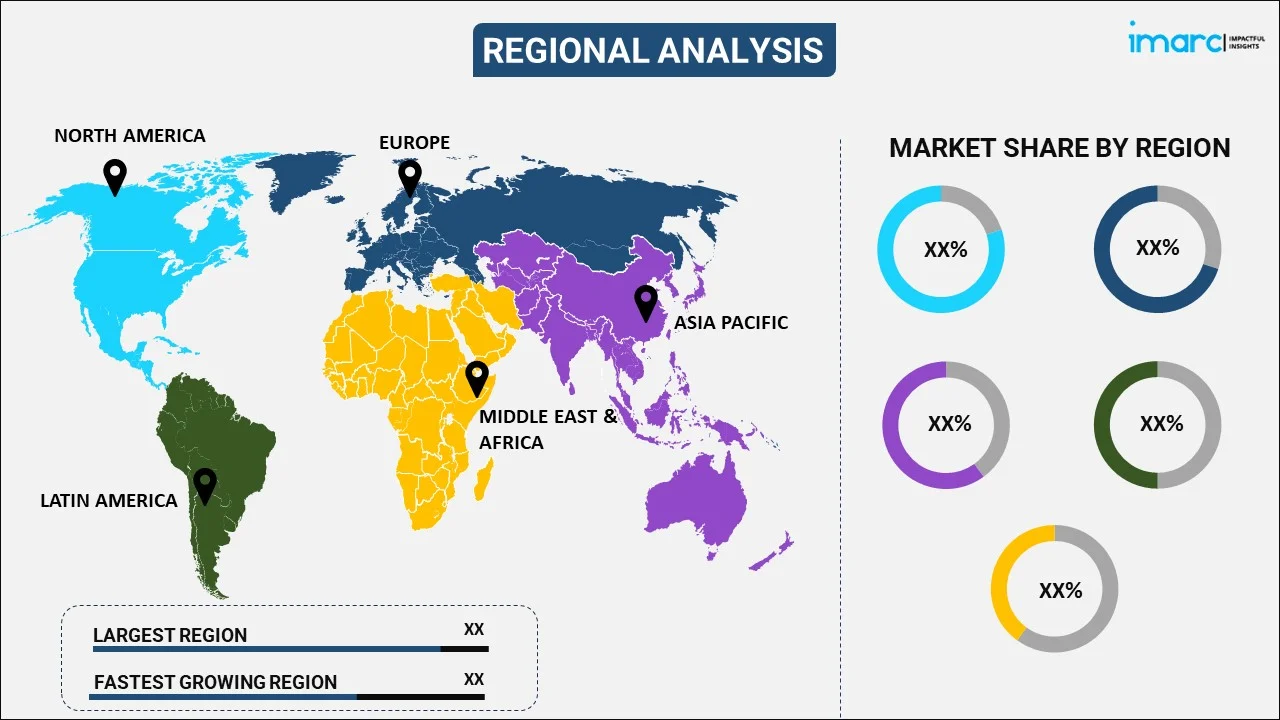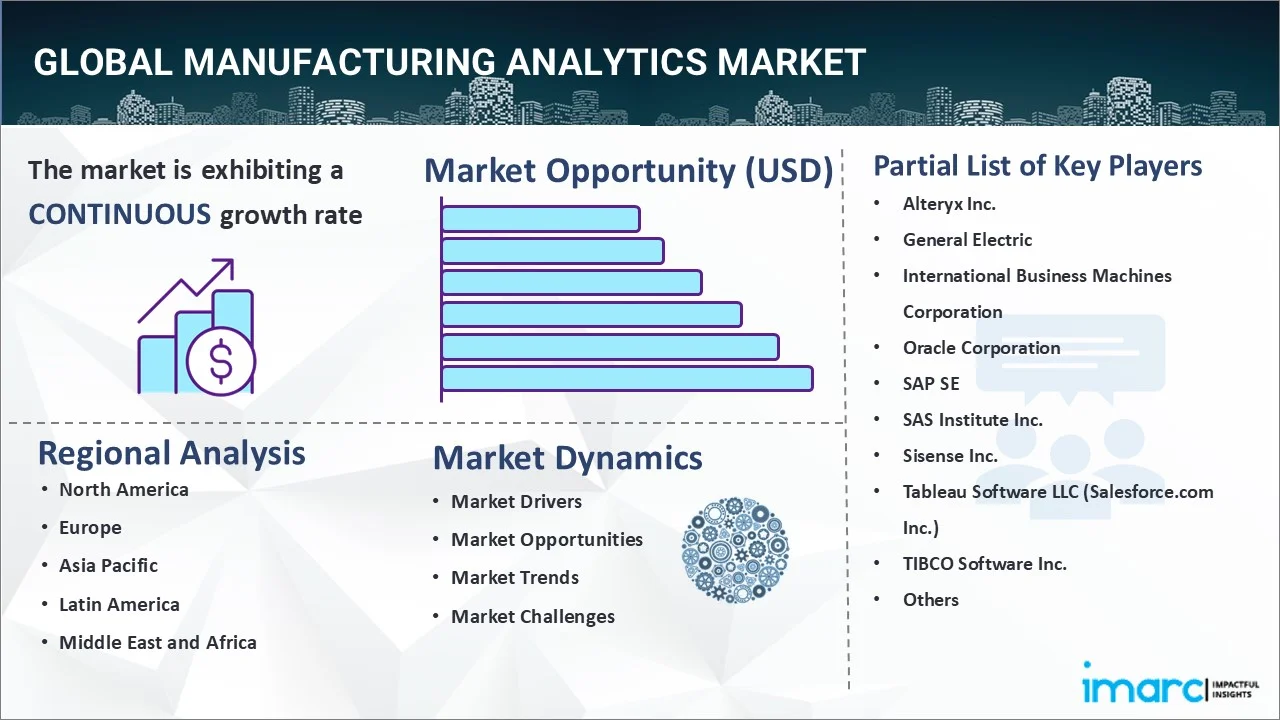
Manufacturing Analytics Market Report by Component (Software, Services), Deployment Model (Cloud-based, On-premises), Application (Predictive Maintenance, Inventory Management, Supply Chain Optimization, and Others), Industry Vertical (Semiconductor and Electronics, Energy and Power, Pharmaceutical, Automobile, Heavy Metal and Machine Manufacturing, and Others), and Region 2025-2033
Global Manufacturing Analytics Market:
The global manufacturing analytics market size reached USD 15.2 Billion in 2024. Looking forward, IMARC Group expects the market to reach USD 65.8 Billion by 2033, exhibiting a growth rate (CAGR) of 17.7% during 2025-2033. The emerging trend of automation in industrial processes, along with the development of Industry 4.0 trends, is primarily augmenting the market growth.
|
Report Attribute
|
Key Statistics
|
|---|---|
|
Base Year
|
2024
|
|
Forecast Years
|
2025-2033
|
|
Historical Years
|
2019-2024
|
|
Market Size in 2024
|
USD 15.2 Billion |
|
Market Forecast in 2033
|
USD 65.8 Billion |
| Market Growth Rate 2025-2033 | 17.7% |
Global Manufacturing Analytics Market Analysis:
- Major Market Drivers: The development of the Industrial Internet of Things (IIoT), along with the growing business scalability and agility, is catalyzing the usage of advanced data management strategies for process optimization. This, in turn, is primarily augmenting the manufacturing analytics market share. Moreover, the escalating demand for smart manufacturing analytics solutions is also acting as another significant growth-inducing factor.
- Key Market Trends: Some of the common manufacturing analytics market trends include the growing focus on predictive maintenance, as it helps in reducing downtime, improving overall equipment effectiveness, optimizing maintenance costs, etc., and the rising popularity of IIoT and big data analytics.
- Geographical Trend: According to the report, North America holds the largest regional market for manufacturing analytics. This is due to the presence of well-established advanced technological infrastructures and the expanding manufacturing sector in the region.
- Competitive Landscape: Some of the manufacturing analytics market companies are Alteryx Inc., General Electric, International Business Machines Corporation, Oracle Corporation, SAP SE, SAS Institute Inc., Sisense Inc., Tableau Software LLC (Salesforce.com Inc.), TIBCO Software Inc., Wipro Limited, and Zensar Technologies Ltd.
- Challenges and Opportunities: According to the manufacturing analytics market research, some of the key market restraints include the rising data security and privacy concerns. Manufacturers are required to ensure the integrity of their data to prevent unauthorized access, which can be a major challenge in market growth. Besides this, the growing adoption of manufacturing analytics needs a skilled workforce with expertise in machine learning, data analytics, statistical modeling, etc. Consequently, the shortage of such skilled professionals poses a restraint in the manufacturing analytics market demand.
Global Manufacturing Analytics Market Trends:
The Rising Investments in Big Data Technologies
The vast amount of data generated from the connected equipment in manufacturing processes needs to be systematically operated, stored, and extracted. This data can be analyzed to gain useful insights into the efficiency and productivity of manufacturing processes, which is one of the key factors in the manufacturing analytics market outlook. In line with this, leading manufacturers are extensively investing in big data technology to maximize their revenue. For instance, according to a survey conducted by Honeywell, 67% of manufacturers are widely investing in Big Data and IIoT for solving business issues. It also showcased that Big Data integrated with analytics can assist in minimizing equipment breakdown, unscheduled maintenance, unscheduled downtime, supply chain management problems, etc.
The Increasing Usage of the Industrial Internet of Things (IIoT)
Owing to the widespread adoption of the Industrial IoT in smart manufacturing processes, more data can be generated from progressively connected equipment systems. In addition to this, leading players are enhancing their capabilities to be compatible with the IIoT ecosystem, which supports integration with data analytics. For example, online cloud and analytic companies, including Microsoft and GE, are expanding the capabilities of the IIoT with edge computing by adopting operating systems that will run Docker containers on the IIoT devices. This, in turn, allows the data processing to run closer to the machines to offer both near real-time feedback and reduced costs by sending less data to the cloud.
Strategic Collaborations and Partnerships among Key Companies
According to the manufacturing analytics market report, key industry players are collaborating to expand their products and meet stringent quality requirements implemented by government bodies. For instance, TIBCO Software Inc. announced its collaboration with Singapore Polytechnic (SP) to expand data analytics and the Internet of Things (IoT). It was a part of the policies of the country to promote local entrepreneurs. As part of the agreement, SP and TIBCO expanded the network of universities in Singapore, TIBCO’s regional hub, thereby offering innovations. Furthermore, Alteryx Inc. announced its new office opening in Tokyo. The new office supported the success of hundreds of current customers in the country, including Honda and Toyo Engineering, and the escalating demand for its end-to-end analytics and data science platform in the broader APAC market. According to the manufacturing analytics market analysis, the office opening was indicative of the company’s 96% growth in international markets for the full year, which accounted for 29% of overall revenue.
Manufacturing Analytics Industry Segmentation:
IMARC Group provides an analysis of the key trends in each segment of the global manufacturing analytics market report, along with forecasts at the global, regional, and country levels from 2025-2033. Our report has categorized the market based on component, deployment model, application and industry vertical.
Breakup by Component:

- Software
- Services
Software dominates the market
The report has provided a detailed breakup and analysis of the market based on the components. This includes software and services. According to the report, software represented the largest segment.
Leading companies across the globe are developing enhanced software solutions for manufacturing analytics processes for inventory management, real-time quality monitoring, enhancing overall productivity and profitability, etc. This, in turn, is expected to fuel the manufacturing analytics software market over the forecasted period. For example, Datanomix collaborated with Hexagon to introduce its automated production intelligence software to global manufacturing customers. The software simplified the monitoring of production processes and provided enhanced efficiency. Also, the partnership aligned with the vision of Hexagon for autonomous manufacturing and the focus of Datanomix on automated production insights. These collaborations are expected to augment the software segment in the manufacturing analytics market in the coming years.
Breakup by Deployment Model:
- Cloud-based
- On-premises
On-premises exhibit a clear dominance in the market
A detailed breakup and analysis of the market based on the deployment model has also been provided in the report. This includes cloud-based and on-premises. According to the report, on-premises accounted for the largest market share.
Breakup by Application:
- Predictive Maintenance
- Inventory Management
- Supply Chain Optimization
- Others
Predictive maintenance currently accounts for the majority of the global market share
The report has provided a detailed breakup and analysis of the market based on the application. This includes predictive maintenance, inventory management, supply chain optimization, and others. According to the report, predictive maintenance represented the largest segment.
Predictive maintenance solutions are gaining extensive traction, owing to factors such as easy access to data, remote access to data, unification of information, reduced costs, and automatic updates, among others, associated with cloud-based deployment. For example, Google Cloud launched Manufacturing Data Engine and Manufacturing Connect, two new solutions specifically designed to enable manufacturers to connect historically siloed assets, improve the visibility from the factory floor to the cloud, and process and standardize data.
Breakup by Industry Vertical:
- Semiconductor and Electronics
- Energy and Power
- Pharmaceutical
- Automobile
- Heavy Metal and Machine Manufacturing
- Others
Currently, automobile exhibits a clear dominance in the market
The report has provided a detailed breakup and analysis of the market based on the industry vertical. This includes semiconductors and electronics, energy and power, pharmaceutical, automobile, heavy metal and machine manufacturing, and others. According to the report, automobile represented the largest segment.
The rising inclination towards more data-driven insights in the automotive industry to avoid the costs associated with over-inventory stocking and faulty assembly is propelling the need for manufacturing analytics for the maintenance of the assembly lines more accurately.
Breakup by Region:

- North America
- United States
- Canada
- Asia-Pacific
- China
- Japan
- India
- South Korea
- Australia
- Indonesia
- Others
- Europe
- Germany
- France
- United Kingdom
- Italy
- Spain
- Russia
- Others
- Latin America
- Brazil
- Mexico
- Others
- Middle East and Africa
North America exhibits a clear dominance in the market
The report has also provided a comprehensive analysis of all the major regional markets, which include North America (the United States and Canada); Asia Pacific (China, Japan, India, South Korea, Australia, Indonesia, and others); Europe (Germany, France, the United Kingdom, Italy, Spain, Russia, and others); Latin America (Brazil, Mexico, and others); and the Middle East and Africa. According to the report, North America was the largest regional market for manufacturing analytics.
According to the manufacturing analytics market overview, the wide presence of some of the prominent players in North America, such as IBM Corporation, General Electric Company, SAP SE, and TIBCO Software, is primarily propelling the regional market.
Competitive Landscape:
The report has provided a comprehensive analysis of the competitive landscape in the market. Detailed profiles of all major companies have also been provided. Some of the manufacturing analytics top companies are listed below:
- Alteryx Inc.
- General Electric
- International Business Machines Corporation
- Oracle Corporation
- SAP SE
- SAS Institute Inc.
- Sisense Inc.
- Tableau Software LLC (Salesforce.com Inc.)
- TIBCO Software Inc.
- Wipro Limited
- Zensar Technologies Ltd
(Please note that this is only a partial list of the key players, and the complete list is provided in the report.)
Global Manufacturing Analytics Market News:
- April 2023: Microsoft announced the launch of its new Azure Industrial IoT Suite. This suite of services aided manufacturers in deploying, building, and managing IoT solutions.
- March 2023: IBM announced the development of its new Watson IoT Platform for Manufacturing. The platform gained extensive traction, as it helped in collecting, storing, and analyze data from their IoT devices.
- February 2023: SAP announced the acquisition of TIBCO Software, a leading provider of data integration and analytics solutions. This acquisition assisted SAP in expanding its manufacturing analytics capabilities and offered a more comprehensive solution to its customers.
Manufacturing Analytics Market Report Coverage:
| Report Features | Details |
|---|---|
| Base Year of the Analysis | 2024 |
| Historical Period | 2019-2024 |
| Forecast Period | 2025-2033 |
| Units | Billion USD |
| Segment Coverage | Component, Deployment Model, Application, Industry Vertical, Region |
| Region Covered | Asia Pacific, Europe, North America, Latin America, Middle East and Africa |
| Countries Covered | United States, Canada, Germany, France, United Kingdom, Italy, Spain, Russia, China, Japan, India, South Korea, Australia, Indonesia, Brazil, Mexico |
| Companies Covered | Alteryx Inc., General Electric, International Business Machines Corporation, Oracle Corporation, SAP SE, SAS Institute Inc., Sisense Inc., Tableau Software LLC (Salesforce.com Inc.), TIBCO Software Inc., Wipro Limited, Zensar Technologies Ltd., etc. |
| Customization Scope | 10% Free Customization |
| Post-Sale Analyst Support | 10-12 Weeks |
| Delivery Format | PDF and Excel through Email (We can also provide the editable version of the report in PPT/Word format on special request) |
Key Benefits for Stakeholders:
- IMARC’s report offers a comprehensive quantitative analysis of various market segments, historical and current market trends, market forecasts, and dynamics of the manufacturing analytics market from 2019-2033.
- The manufacturing analytics market research report provides the latest information on the market drivers, challenges, and opportunities in the global market.
- The study maps the leading, as well as the fastest-growing, regional markets. It further enables stakeholders to identify the key country-level markets within each region.
- Porter's five forces analysis assist stakeholders in assessing the impact of new entrants, competitive rivalry, supplier power, buyer power, and the threat of substitution. It helps stakeholders to analyze the level of competition within the manufacturing analytics industry and its attractiveness.
- Competitive landscape allows stakeholders to understand their competitive environment and provides an insight into the current positions of key players in the market.
Key Questions Answered in This Report
The global manufacturing analytics market was valued at USD 15.2 Billion in 2024.
We expect the global manufacturing analytics market to exhibit a CAGR of 17.7% during 2025-2033.
The emerging automation trend in industrial processes, along with the rising adoption of manufacturing analytics, as it assists in demand forecasting, real-time quality monitoring, and inventory management, is primarily driving the global manufacturing analytics market.
The sudden outbreak of the COVID-19 pandemic had led to the implementation of stringent lockdown regulations across several nations, resulting in the temporary closure of numerous manufacturing units, thereby negatively impacting the global market for manufacturing analytics.
Based on the component, the global manufacturing analytics market has been segmented into software and services, where software currently holds the majority of the total market share.
Based on the deployment model, the global manufacturing analytics market can be divided into cloud-based and on-premises. Currently, on-premises exhibit a clear dominance in the market.
Based on the application, the global manufacturing analytics market has been categorized into predictive maintenance, inventory management, supply chain optimization, and others. Among these, predictive maintenance currently accounts for the majority of the global market share.
Based on the industry vertical, the global manufacturing analytics market can be segregated into semiconductor and electronics, energy and power, pharmaceutical, automobile, heavy metal and machine manufacturing, and others. Currently, automobile exhibits a clear dominance in the market.
On a regional level, the market has been classified into North America, Asia-Pacific, Europe, Latin America, and Middle East and Africa, where North America currently dominates the global market.
Some of the major players in the global manufacturing analytics market include Alteryx Inc., General Electric, International Business Machines Corporation, Oracle Corporation, SAP SE, SAS Institute Inc., Sisense Inc., Tableau Software LLC (Salesforce.com Inc.), TIBCO Software Inc., Wipro Limited, and Zensar Technologies Ltd.
Need more help?
- Speak to our experienced analysts for insights on the current market scenarios.
- Include additional segments and countries to customize the report as per your requirement.
- Gain an unparalleled competitive advantage in your domain by understanding how to utilize the report and positively impacting your operations and revenue.
- For further assistance, please connect with our analysts.

 Inquire Before Buying
Inquire Before Buying
 Speak to an Analyst
Speak to an Analyst
 Request Brochure
Request Brochure
 Request Customization
Request Customization




.webp)




.webp)












